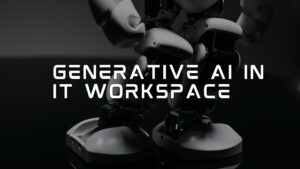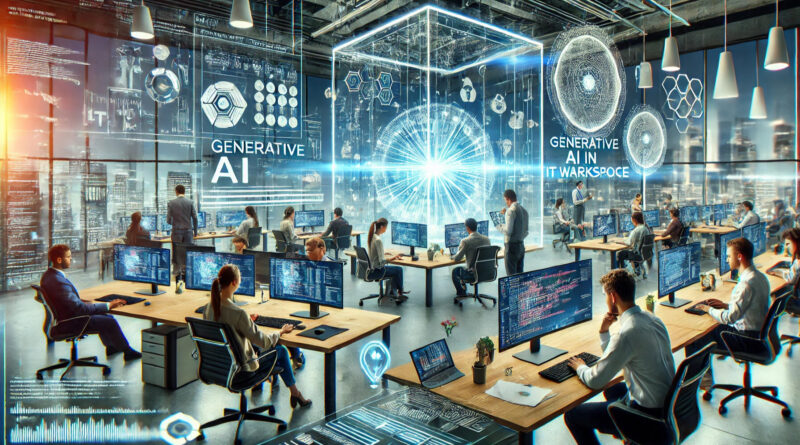How Generative AI in IT Workspace Drives Innovation and How to Create It
In today’s fast-paced digital world, innovation has become the backbone of every organization’s success. Information Technology (IT) departments are no longer just the support systems they once were; they are at the heart of driving transformative change. One of the most significant advancements in recent years is Generative AI. This cutting-edge technology has the power to not only streamline processes but also create new possibilities, fostering innovation across various domains within IT.

Generative AI refers to AI systems that can create new content, be it text, images, code, or even designs, based on patterns they learn from large datasets. In the context of generative AI in IT workspace, generative AI is a game-changer. It drives efficiency, accelerates problem-solving, enhances creativity, and helps in predictive analytics. But how exactly does Generative AI achieve this, and what steps should organizations take to integrate it into their IT infrastructure? This blog will delve into these questions.
How Generative AI is Driving Innovation in IT Workspaces
1. Automating Repetitive Tasks
IT departments often face the challenge of handling repetitive and mundane tasks. These can range from writing simple code to generating reports or troubleshooting system errors. Traditionally, these tasks would consume a significant amount of time and resources. Generative AI can automate these processes with remarkable accuracy.
For instance, AI-driven code generators like GitHub Copilot can assist developers by auto-completing code based on given prompts, reducing time spent on repetitive coding tasks. Similarly, AI can automate report generation, network monitoring, system diagnostics, and even customer support via AI chatbots. This automation frees up valuable resources, allowing IT professionals to focus on more strategic and innovative projects.
2. Enhancing Creativity and Problem-Solving
One of the most profound ways in which Generative AI drives innovation is by enhancing creativity and problem-solving capabilities. For example, generative models such as OpenAI’s GPT-3 can help IT professionals think outside the box by suggesting solutions or ideas that they may not have considered. Whether it’s generating new algorithms, suggesting new software architectures, or brainstorming different approaches to a project, generative AI can act as a co-creator, offering suggestions that fuel creativity.
Moreover, Generative AI is invaluable in tackling complex problems that require innovative solutions. By simulating different scenarios, AI systems can provide new perspectives and approaches that human experts might overlook. In software development, Generative AI tools can propose novel ways to optimize code, predict security vulnerabilities, and even generate synthetic data for testing purposes.
3. Accelerating Development and Prototyping
Generative AI drastically accelerates the development cycle by assisting in faster prototyping. Whether it’s a new product or an IT solution, generative models can quickly create iterations, enabling rapid testing and improvements. For example, in software development, AI-powered tools can generate code snippets or entire software modules based on user input, speeding up the development process.
AI also plays a significant role in creating and iterating on designs. Whether for applications, websites, or even hardware, generative AI tools can offer multiple design alternatives based on a set of given parameters. This capability can significantly reduce time-to-market for new products and services, giving companies a competitive edge.
4. Predictive Analytics and Forecasting
One of the most powerful aspects of Generative AI is its ability to generate predictions and forecasts based on existing data. Predictive analytics can be used to forecast system failures, anticipate network bottlenecks, or predict future trends in IT operations. By analyzing large datasets, AI models can create predictive models that help IT teams to act proactively, minimizing downtime and optimizing resources.
For instance, AI systems can analyze historical data to predict when hardware might fail, allowing for timely maintenance. They can also help in forecasting IT infrastructure requirements, enabling businesses to scale efficiently based on anticipated demand.
5. Personalized User Experience
Generative AI is also transforming how IT departments deliver personalized experiences for employees and customers. AI algorithms can generate tailored experiences based on user behavior, preferences, and historical data. For example, intelligent recommendation systems can help personalize the tools and applications an employee uses, making their work processes more efficient.
Moreover, AI can be leveraged to develop more intuitive interfaces for software and systems, reducing the learning curve for users and improving overall user satisfaction. With the power of generative models, IT departments can create solutions that are not only functional but also engaging and user-friendly.
6. Improved Decision-Making
Data-driven decision-making is at the core of modern IT management. Generative AI enhances decision-making by generating insights from massive datasets and offering actionable recommendations. In complex IT environments, where decisions need to be made quickly and accurately, AI systems can generate data-driven insights that help IT managers make informed choices.
For example, an IT manager can use AI to simulate different scenarios of network expansion and assess the impact of each scenario on performance and cost. This helps in making more strategic, data-backed decisions about investments, resources, and infrastructure.
7. AI-Driven Cybersecurity
Cybersecurity is one of the most critical areas where AI is making a profound impact. Generative adversarial networks (GANs), a subset of generative AI, are used to identify vulnerabilities in systems, predict cyberattacks, and develop defenses against them. By generating new patterns and detecting anomalies in real-time, AI models can prevent potential breaches and reduce the risk of cyber threats.
Generative AI can also generate synthetic data for testing security systems, helping IT professionals detect potential vulnerabilities before they can be exploited. Furthermore, AI can assist in automating threat response, such as identifying and isolating compromised systems during a breach.
How to Create Generative AI in the IT Workspace
Integrating Generative AI into an IT workspace requires careful planning, infrastructure, and a clear understanding of the organization’s goals. Here’s a step-by-step guide to creating generative AI solutions in your IT environment.
1. Define Clear Objectives
Before implementing Generative AI, it’s essential to define what you want to achieve. Are you looking to automate tasks, improve system security, enhance decision-making, or boost creativity? Understanding your objectives will help you choose the right generative AI tools and models that align with your business needs.
2. Build or Adopt the Right AI Infrastructure
Generative AI requires substantial computational power, so it’s crucial to build or adopt the right infrastructure. This may involve investing in high-performance cloud computing resources or on-premise data centers equipped with GPUs that can handle the heavy workload of AI models.
For organizations starting out, cloud providers like AWS, Azure, and Google Cloud offer pre-built AI services that can help get started quickly without the need for a heavy upfront investment.
3. Leverage Existing AI Models and Frameworks
Rather than building a generative AI model from scratch, businesses can leverage existing pre-trained models. Popular AI frameworks like TensorFlow, PyTorch, and OpenAI’s GPT models can be customized to fit your organization’s needs. These models are already trained on vast amounts of data and can be adapted to generate text, images, code, or any other content relevant to your IT needs.
4. Gather and Prepare Data
Generative AI models are only as good as the data they are trained on. It’s essential to gather high-quality, relevant data to feed into the AI system. This could include code repositories, system logs, user behavior data, and more. Clean, well-organized datasets are crucial to ensure the quality and accuracy of the outputs generated by the AI.
5. Train and Fine-Tune the AI Model
Once the data is prepared, the next step is to train the AI model. Depending on the use case, training might involve supervised learning (where the AI is trained on labeled data) or unsupervised learning (where the AI learns patterns in the data on its own).
Fine-tuning is also necessary to improve the model’s performance. Over time, the AI system should be continuously trained with new data to improve accuracy and adapt to changes in the IT environment.
6. Integrate into IT Workflow
After the model is trained, it’s time to integrate the generative AI solution into your IT workflow. This could mean incorporating AI-driven automation into software development pipelines, using AI-powered decision-making tools in IT management systems, or implementing AI-driven cybersecurity protocols.
7. Monitor, Evaluate, and Improve
AI systems require constant monitoring and evaluation to ensure they perform optimally. Track key metrics like accuracy, efficiency, and user feedback to measure the success of your AI implementation. Based on the insights gathered, refine and improve the models to ensure they continue to drive innovation within your IT workspace.
Conclusion
Generative AI is a powerful tool that’s reshaping how IT departments operate. By automating repetitive tasks, accelerating development, enhancing creativity, and improving decision-making, generative AI is driving innovation generative AI in IT workspace. With the right infrastructure, data, and strategy, organizations can harness this technology to streamline their operations and remain competitive in an increasingly AI-driven world. As generative AI evolves, its potential to spark further innovation and solve complex problems will only continue to grow, transforming IT departments into hubs of creativity and efficiency.



